A) 18 N
B) 15 N
C) 2.9 N
D) 3.5 N
Correct Answer

verified
Correct Answer
verified
Multiple Choice
The figure shows two packages that start sliding down a 20° ramp from rest a distance d = 6.6 m along the ramp from the bottom. Package A has a mass of 5.0 kg and a coefficient of kinetic friction 0.20 between it and the ramp. Package B has a mass of 10 kg and a coefficient of kinetic friction 0.15 between it and the ramp. How long does it take package A to reach the bottom? 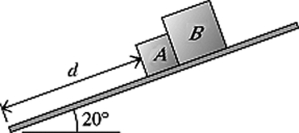
A) 2.7 s
B) 3.0 s
C) 3.2 s
D) 3.5 s
Correct Answer

verified
Correct Answer
verified
Multiple Choice
A box slides down a frictionless plane inclined at an angle θ above the horizontal. The gravitational force on the box is directed
A) parallel to the plane in the same direction as the movement of the box.
B) parallel to the plane in the opposite direction as the movement of the box.
C) perpendicular to the plane.
D) vertically.
E) at an angle θ below the inclined plane.
Correct Answer

verified
Correct Answer
verified
Multiple Choice
A 4.00-kg box sits atop a 10.0-kg box on a horizontal table. The coefficient of kinetic friction between the two boxes and between the lower box and the table is 0.600, while the coefficient of static friction between these same surfaces is 0.800. A horizontal pull to the right is exerted on the lower box, as shown in the figure, and the boxes move together. What is the friction force on the UPPER box? 
A) 19.3 N to the right
B) 19.3 N to the left
C) 23.5 N to the right
D) 31.4 N to the right
E) 31.4 N to the left
Correct Answer

verified
Correct Answer
verified
Multiple Choice
A driver in a 1000 kg car traveling at 20 m/s slams on the brakes and skids to a stop. If the coefficient of friction between the tires and the horizontal road is 0.80, how long will the skid marks be?
A) 26 m
B) 21 m
C) 33 m
D) 24 m
Correct Answer

verified
Correct Answer
verified
Multiple Choice
A rope pulls on the lower block in the figure with a tension force of 20 N. The coefficient of kinetic friction between the lower block and the surface is 0.16. The coefficient of kinetic friction between the lower block and the upper block is also 0.16. The pulley has no appreciable mass or friction. What is the acceleration of the 2.0 kg block? 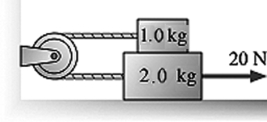
A) 4.1 m/s2
B) 5.1 m/s2
C) 8.4 m/s2
D) 9.2 m/s2
Correct Answer

verified
Correct Answer
verified
Multiple Choice
A car enters a 300-m radius horizontal curve on a rainy day when the coefficient of static friction between its tires and the road is 0.600. What is the maximum speed at which the car can travel around this curve without sliding?
A) 29.6 m/s
B) 33.1 m/s
C) 24.8 m/s
D) 42.0 m/s
E) 37.9 m/s
Correct Answer

verified
Correct Answer
verified
Multiple Choice
The figure shows a 2000 kg cable car descending a high hill. A counterweight of mass 1800 kg on the other side of the hill aids the brakes in controlling the cable car's speed. The rolling friction of both the cable car and the counterweight are negligible. How much braking force does the cable car need to descend at constant speed? 
A) 3800 N
B) 2900 N
C) 2000 N
D) 980 N
Correct Answer

verified
Correct Answer
verified
Multiple Choice
A system of blocks and a frictionless pulley is shown in the figure. Block A has a mass of 2.0 kg and is on a rough horizontal surface for which μs = 0.40 between the surface and block A. The rope pulls horizontally on block A. Block C has a mass of 1.0 kg. An external force P = 23.0 N, applied vertically to block A, maintains the system at rest as shown in the figure. What is the friction force on block A? 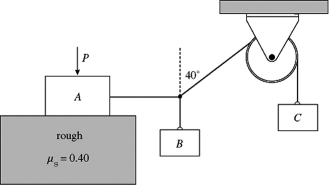
A) 6.3 N
B) 6.9 N
C) 7.5 N
D) 5.7 N
E) 5.1 N
Correct Answer

verified
Correct Answer
verified
Multiple Choice
Block A of mass 5.0 kg and block X are attached to a rope which passes over a pulley, as shown in the figure. An 80-N force P is applied horizontally to block A, keeping it in contact with a rough vertical face. The coefficients of static and kinetic friction between the wall and block A are μs = 0.40 and μk = 0.30. The pulley is light and frictionless. The mass of block X is adjusted until block A moves upward with an acceleration of 1.6 m/s2. What is the mass of block X? 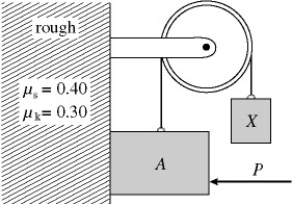
A) 9.9 kg
B) 9.3 kg
C) 8.7 kg
D) 8.1 kg
E) 7.5 kg
Correct Answer

verified
Correct Answer
verified
Multiple Choice
The figure shows a 100-kg block being released from rest from a height of 1.0 m. It then takes it 0.90 s to reach the floor. What is the mass m of the other block? The pulley has no appreciable mass or friction. 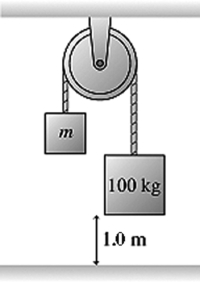
A) 60 kg
B) 54 kg
C) 48 kg
D) 42 kg
Correct Answer

verified
Correct Answer
verified
Multiple Choice
Kieran takes off from rest down a 50 m high, 10° slope on his jet-powered skis. The skis have a thrust of 280 N parallel to the surface of the slope. The combined mass of skis and Kieran is 50 kg (the fuel mass is negligible) . Kieran's speed at the bottom is 40 m/s. What is the coefficient of kinetic friction of his skis on snow?
A) 0.47
B) 0.58
C) 0.23
D) 0.29
Correct Answer

verified
Correct Answer
verified
Multiple Choice
A 600-kg car traveling at 30.0 m/s is going around a curve having a radius of 120 m that is banked at an angle of 25.0°. The coefficient of static friction between the car's tires and the road is 0.300. What is the magnitude of the force exerted by friction on the car?
A) 1590 N
B) 3430 N
C) 7240 N
D) 7820 N
E) 795 N
Correct Answer

verified
Correct Answer
verified
Multiple Choice
A 23 kg mass is connected to a nail on a frictionless table by a massless string 1.3 m long. There is no appreciable friction between the nail and the string. If the tension in the string is 51 N while the mass moves in a uniform circle on the table, how long does it take for the mass to make one complete revolution?
A) 4.8 s
B) 3.8 s
C) 4.5 s
D) 5.2 s
Correct Answer

verified
Correct Answer
verified
Multiple Choice
Which one of the following free-body diagrams best represents the free-body diagram, with correct relative force magnitudes, of a person in an elevator that is traveling upward but is gradually slowing down at a rate of 9 m/s2?  f is the force of the floor on the person and
f is the force of the floor on the person and  g is the force of gravity on the person.
g is the force of gravity on the person.
A) ![]()
B) ![]()
C) ![]()
D) ![]()
E) ![]()
Correct Answer

verified
Correct Answer
verified
Multiple Choice
Three objects are connected by massless wires over a massless frictionless pulley as shown in the figure. The tension in the wire connecting the 10.0-kg and 15.0-kg objects is measured to be 133 N. What is the mass M? 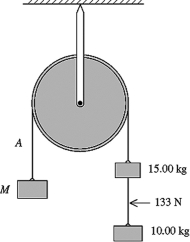
A) 8.33 kg
B) 33.9 kg
C) 35.0 kg
D) 52.8 kg
E) 95.0 kg
Correct Answer

verified
Correct Answer
verified
Multiple Choice
Two objects having masses m1 and m2 are connected to each other as shown in the figure and are released from rest. There is no friction on the table surface or in the pulley. The masses of the pulley and the string connecting the objects are completely negligible. What must be true about the tension T in the string just after the objects are released? 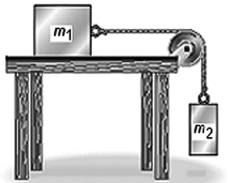
A) T = m2g
B) T > m2g
C) T < m2g
D) T = m1g
E) T > m1g
Correct Answer

verified
Correct Answer
verified
Multiple Choice
A traffic light weighing 100 N is supported by two ropes as shown in the figure. The tensions in the ropes are closest to 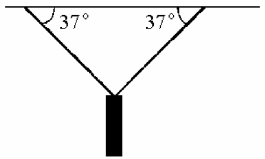
A) 50 N.
B) 56 N.
C) 63 N.
D) 66 N.
E) 83 N.
Correct Answer

verified
Correct Answer
verified
Multiple Choice
Three objects are connected as shown in the figure. The strings and frictionless pulleys have negligible masses, and the coefficient of kinetic friction between the 2.0-kg block and the table is 0.25. What is the acceleration of the 2.0-kg block? 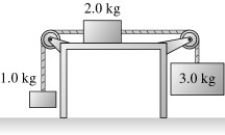
A) 2.5 m/s2
B) 1.7 m/s2
C) 3.2 m/s2
D) 4.0 m/s2
Correct Answer

verified
Correct Answer
verified
Multiple Choice
In the figure, two wooden blocks each of 0.30 kg mass are connected by a string that passes over a very light frictionless pulley. One block slides on a horizontal table, while the other hangs suspended by the string, as shown in the figure. At time t = 0, the suspended block is 0.80 m over the floor, and the blocks are released from rest. After 2.5 s, the suspended block reaches the floor. What is the coefficient of kinetic friction between the table and the sliding block? 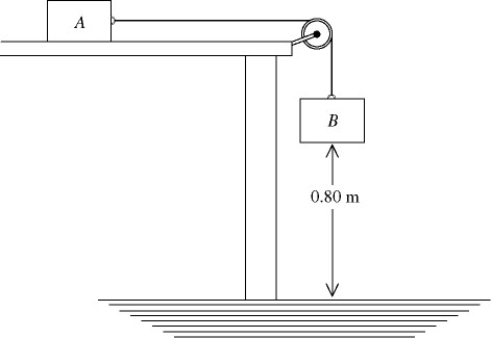
A) 0.35
B) 0.52
C) 0.84
D) 0.65
E) 0.95
Correct Answer

verified
Correct Answer
verified
Showing 61 - 80 of 95
Related Exams